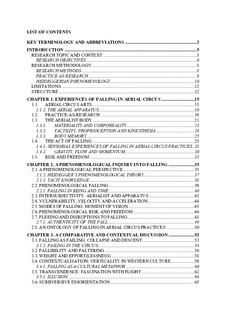| dc.contributor.advisor | Fiskvik, Anne Margrete | |
| dc.contributor.advisor | Damkjaer, Camilla | |
| dc.contributor.author | Havelund-Willett, Julie | |
| dc.date.accessioned | 2018-03-20T09:18:53Z | |
| dc.date.available | 2018-03-20T09:18:53Z | |
| dc.date.issued | 2016 | |
| dc.identifier.uri | http://hdl.handle.net/11250/2491191 | |
| dc.description.abstract | Denne afhandling argumenterer for vigtigheden af at falde, ved at belyse relationer mellem cirkusluftartisteri og fænomenologi. Fald er analyseret som fænomener der muliggør alternative perspektiver på vertikalitet, risici, frihed og desorientering. Det kvalitative forskningsdesign inkluderer teoretisk forskning inden for fald i en række tekstsammenhænge inklusive Heideggers fænomenologi, og på lige fod Practice-as-Research (PaR) som består af fysisk cirkusluftartisteritræning på aerial silks. Igennem processen med at falde på silks, er flere afgørende temaer inden for luftartisteri udforsket, inklusive kinæstesi, rumlig orientering og luftartistens forhold til apparatet. Afhandlingen bibringer en sammenligning mellem det konkrete og det konceptuelle begreb at falde, og demonstrerer hvordan metoderne kan forenes ved at bruge en fænomenologisk tilgang til PaR. For at kunne diskutere forskningen konstruktivt, krævede det en abstrakt tilgangsvinkel til Heideggers terminologi.
Hovedlitteratur for afhandlingen inkluderer tekster om at falde af Ann Cooper Albright (2010, 2013) og Emilyn Claid og Ric Allsopp (2013), og cirkusforskning af Peta Tait (1996, 2005, 2006, 2016) og Camila Damkjaer (2011, 2015, 2016), som også er ekstern vejleder for denne afhandling. Fænomenologisk litteratur om Heideggers teorier inkluderer Being and Time (1962, engelsk oversættelse af John Macquarrie og Edward Robinson) af Martin Heidegger såvel som sekundær litteratur af Stephen Mulhall (2005) og Tyler Akers (2015). Indflydelsesrige værker for PaR kom fra Jaana Parviainen (1998, 2002) såvel som Robin Nelson (2006) og Angela Piccini (2002).
Hovedresultaterne omhandler potentialet for at falde som et undergravende redskab I en bredere kontekst. Adskillige eksempler på at falde er introduceret for at identificere hvordan luftartisten, som falder på silks, udfører en transcendental akt af fænomenologisk aktivitet.
De overordnede konklusioner er at fald har potentiale for at agere som brugbare, konstruktive og alternative måder at forbedre modstandskraft og autonomi på. Det bliver argumenteret at luftartistkroppen kan kommunikere ny mening ved at falde, I relation til social selvstændighed, plasticitet og foranderlighed. Bidraget til viden inden for områder om fald, akademisk cirkusforskning og PaR, er en refleksion over sådanne kropslige oplevelser. | nb_NO |
| dc.description.abstract | This thesis serves to argue the importance of falling, through illuminating connections between aerial circus practices and phenomenology. The act of falling is analysed as a phenomenon, which enables an alternative view on notions of verticality, risk, freedom and disorientation. The qualitative research design includes theoretical research on falling in a multitude of contexts. These include Heideggerian phenomenology and Practice-as-Research (PaR), which consisted of physical aerial circus training, specifically on aerial silks. Through the process of falling on silks, several themes pivotal to aerial circus practices are explored including kinaesthesia, spatial orientation and the relationship to the apparatus. The thesis imparts a comparison between the concrete and the conceptual notion of falling, and demonstrates how the methods can be combined by applying a phenomenological lens to PaR. To discuss the research constructively has required an abstract approach to Heideggerian terminology.
Key literature for this thesis includes texts on falling by Ann Cooper Albright (2010, 2013) and Emilyn Claid and Ric Allsopp (2013), and circus research by Peta Tait (1996, 2005, 2006, 2016) and Camila Damkjaer (2011, 2015, 2016), who is also the external supervisor for the thesis. Phenomenological literature on Heideggerian theory include Being and Time (1962, English translation by John Macquarrie and Edward Robinson) by Martin Heidegger as well as secondary literature by Stephen Mulhall (2005) and Tyler Akers (2015). PaR has been greatly influenced by the works of Jaana Parviainen (1998, 2002) as well as Robin Nelson (2006) and Angela Piccini (2002).
The main findings regard the potential for falling as a subversive tool in wider contexts. Various examples of falling are introduced to identify how the aerialist, when falling on silks, performs transcendental acts of phenomenological activity. The overall conclusions view the act of falling as potential for a useful, constructive and alternative way to improve resilience and autonomy. It is argued that the aerialist body has the capacity to communicate new meaning through the act of falling, in relation to social independence, pliability and precariousness. The contribution made to knowledge in the area of falling, academic circus research and PaR is a reflection of such embodied experience. | nb_NO |
| dc.language.iso | eng | nb_NO |
| dc.publisher | NTNU | nb_NO |
| dc.subject | falling | nb_NO |
| dc.subject | aerial circus | nb_NO |
| dc.subject | pheonomenology | nb_NO |
| dc.subject | Martin Heidegger | nb_NO |
| dc.subject | Practice-as-Research | nb_NO |
| dc.subject | PaR | nb_NO |
| dc.title | Phenomenological Falling - An Embodied Exploration of Falling in Aerial Circus Through Heideggerian Theory | nb_NO |
| dc.type | Master thesis | nb_NO |
| dc.subject.nsi | VDP::Humaniora: 000 | nb_NO |

